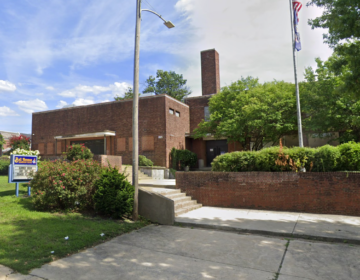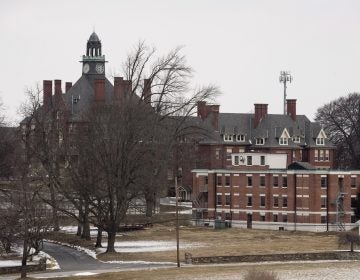Forget Penn and Pitt: Is this little-known school the best deal in Pa. higher-ed?
Ten years after enrolling, graduates of one practical nursing program in Delco earn more than graduates of any other college in Pa., when you account for the cost of school.
Listen 6:04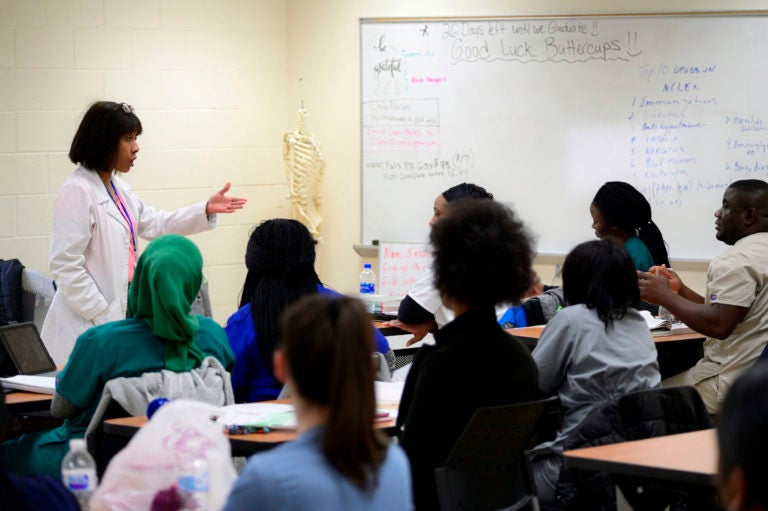
Students attend a nursing class at a school in Delaware County that's garnered an esteemed distinction. (Bas Slabbers for Keystone Crossroads)
In the world of higher education you will find few buildings less remarkable than the Delaware County Technical High School in Broomall, Pennsylvania.
Surrounded by a Rockwellian collage of trimmed lawns and picket fences, the single-story complex sits on a winding suburban lane just west of Philadelphia. It features no markers of prestige — just an ivy-less, brick facade and a drop-off lane for cars and busses.
But inside — along a single hallway — there is a little-known program that ranks with the biggest names in higher education, and, in some cases, outperforms them. By one measure, it’s among the best deals in higher-ed right now — a mighty engine of value in an era where college debt is at the forefront of national politics and overburdened families question the worth of a degree.
For the roughly 100 students who pass through this program every year, it can be a quick ticket to the middle class.
And it may also be a glimpse into the future of higher education.
‘Daddy goes to school’
When Chuka Osakwa decided to go back to school, he had two criteria.
“I wanted something that would be quick and, of course, valuable,” he said.
Osakwa, 37, is a native of Nigeria who immigrated to the United States six years ago and settled in Upper Darby.
He has a wife, two young children, and little time to waste.
“I’m in this sandwich generation,” said Osakwa, who works two jobs. “I have parents that depend on me in Africa. I have kids that depend on me right now.”
So, en route to giving his family more stability, he found himself inside that ivy-less brick facade.
His school’s name is as bland as the building that holds it: the Delaware County Technical Schools Practical Nursing Program. It is, at heart, a quick-turn program that trains students to become licensed practical nurses (LPNs) — a position that’s roughly a half-step below registered nurse.
But the students themselves are a fascinating bunch: college dropouts, older moms reentering the workforce, and scores of immigrants like Osakwa — mostly from West Africa.
Osakwa sometimes comes to class directly from his overnight shift at a nursing home. It’s a grind, and his bloodshot eyes tell the toll.
“My kids know that daddy goes to school and then daddy goes to work,” he said.
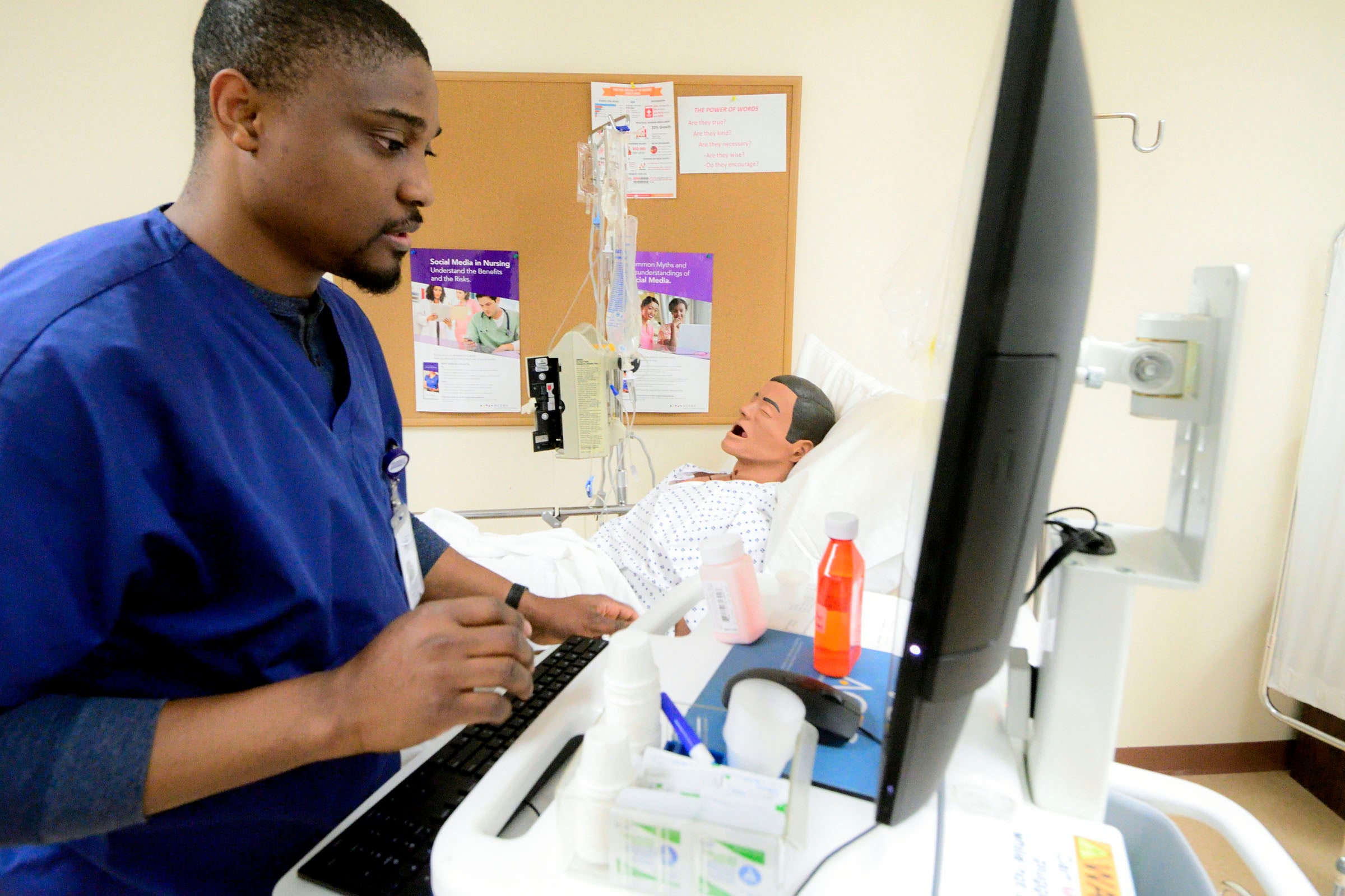
But Osakwa likes health care. He cherishes those moments with ailing patients where he can provide some comfort.
With this program, he sees a pathway to a worthwhile career.
“I want to create a life for myself that I’ll be proud of,” Osakwa said.
Tiny, but mighty
That kind of life feels within reach at Delaware County’s program — and other similar schools sprinkled throughout the country.
Most of these tiny programs last around one year for full-time students and two years for part-timers. They typically cost $20,000 or less, have minimal admissions requirements, and exclusively train students to become LPNs.
According to a new ranking system developed by Georgetown University’s Center on Education and the Workforce, the Delaware County Technical Schools Nursing Program is the single best higher-education program in Pennsylvania based on a metric called 10-year Net Present Value.
Simply put: Ten years after enrolling, graduates of the program earn more than graduates of any other college in Pennsylvania when you account for the cost of school.
“Think about it being what you’re gonna make in your lifetime minus the cost of going to college,” said Martin Van Der Werf, who helped create this metric for 4,500 colleges and higher-ed programs across the country.
In Pennsylvania, the top schools in 10-year NPV don’t remotely resemble the top schools on more traditional lists like the U.S. News and World Report. But it’s chock full of schools like the Delaware County Technical Schools Nursing Program.
The top 10 alone features the Central Susquehanna Intermediate Unit LPN Career in Lewisburg, the Fayette County Career & Technical Institute Practical Nursing Program in Uniontown, and the Lenape Technical School Practical Nursing Program in tiny Ford City.
A decade after enrolling, students from these programs will have made between $285,000 and $363,000 more in salary than they’ll have spent on their college education.
This phenomenon is easy to explain. LPN programs are relatively cheap and America needs health care workers to look after aging baby boomers. LPNs in Pennsylvania make, on average, $48,120 a year, according to the Bureau of Labor Statistics. And the economic picture is even sunnier in the Philadelphia region, where practical nurses average $55,360 annually and make up a larger proportion of the labor force than almost any other major metropolitan area.
Traditional college students have to wait at least four years before reentering the workforce full-time — and in the case of those who opt for graduate school, that wait can be even longer. Practical nurses can earn middle-class wages about a year after enrolling.
In some job-starved parts of Pennsylvania, the local LPN program can be a lifeline.
When a plumbing-fixture factory closed in Ford City, Pennsylvania, about 40 miles northeast of Pittsburgh, laid-off employees lined up at the Lenape Technical Institute’s practical nursing program, said associate director Kimberly Smith.
“Oh my gosh, I must have got 10 men in that class who used to make toilets and now are nurses,” Smith said.
It’s not unusual, administrators say, for former miners and manufacturing workers to pivot to a nursing career — particularly in Western Pennsylvania, where there are fewer industrial jobs and an aging population that needs care.
“We’ve actually had a lot of coal workers who get laid off, they come through our program,” said Amy Dennis, who runs the LPN program for the Fayette County Career and Technical Institute.
Delaware County doesn’t face the same economic headwinds as Western Pennsylvania. But for those students who find their way to Delaware Technical School, the LPN program offers the tantalizing prospect of social mobility in an era where some Americans feel that dream slipping.
‘Crockpot’ university
The Delco program runs five days a week for roughly eight hours a day. Outside of some short holiday breaks, it’s a year-round endeavor.
About 85% of students are eligible for federal Pell Grants — a type of aid reserved for the neediest college students — said program director Kate McNamara. And the average age of entering students is 31, according to Georgetown University’s research.
Tuition is about $16,000, and the price rises to roughly $18,000 when accounting for books and fees. There’s no need to purchase a meal plan or bedding, but McNamara does suggest that young parents in the program buy a crockpot.
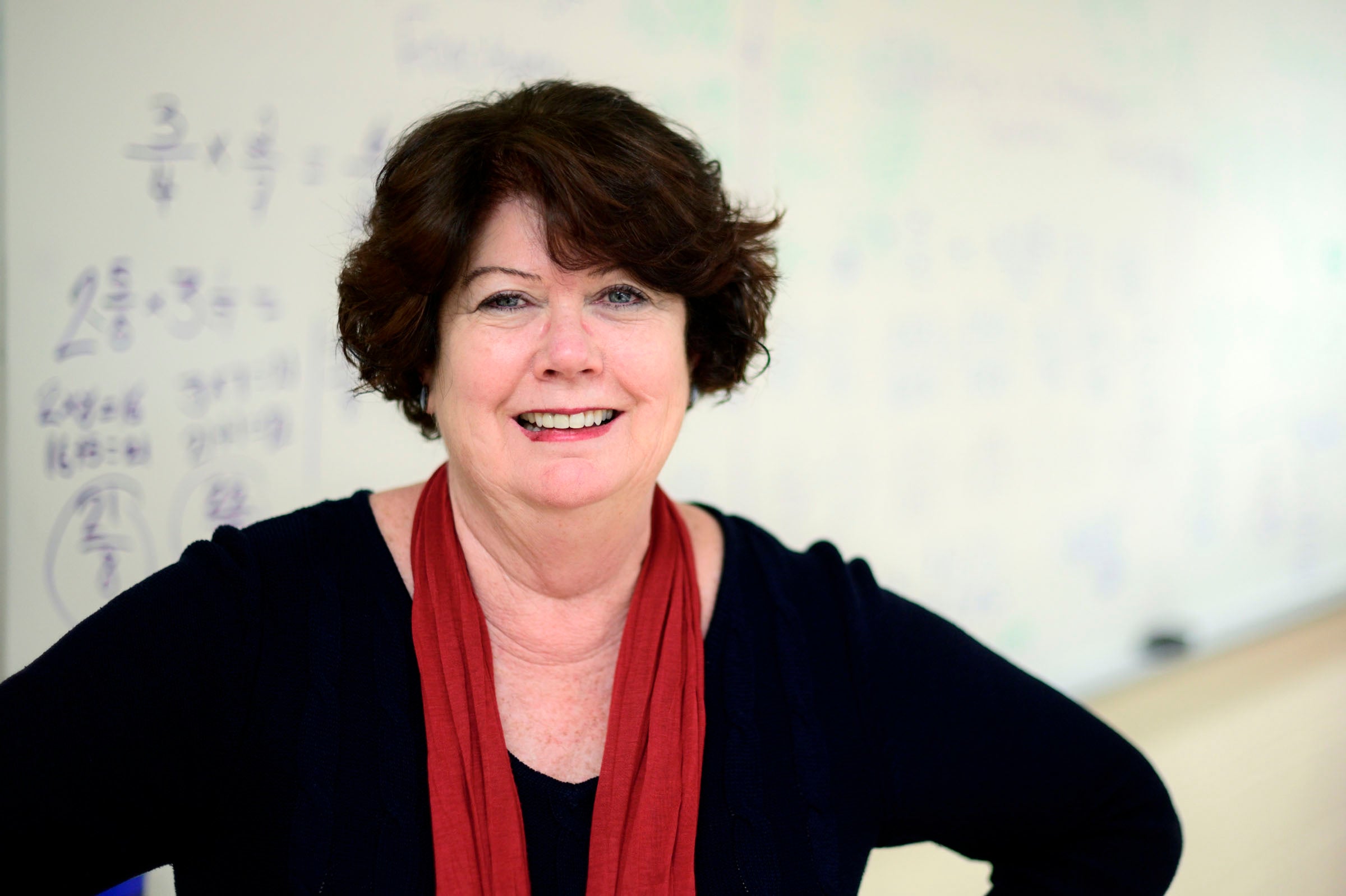
“I’m a very big advocate of crockpot,” McNamara said. “Because it makes it easier for them [to cook dinner] and I want them to spend time with their family.”
Her staff is lean: two administrative assistants and a part-time financial aid consultant gathered in a small warren of carpeted offices.
“There’s very little overhead,” said McNamara, a Delaware County native and nurse who went to college after working as a secretary in a hospital.
The program’s “campus” runs along a single hallway and consists of two standard classrooms, a test-prep room where students study for the all-important licensing exam that follows graduation, and a room full of practice dummies.
To qualify for admission, students must have a high school diploma or an equivalency degree and must score 44% on a standardized test known as the TEAS. On average, seven in 10 students graduate, McNamara said — and about 85% of graduates pass the state licensing exam.
And while licensed practical nurses have fallen out of favor in big hospitals, there’s ravenous demand for their services in retirement centers and long-term-care facilities.
That’s the path 24-year-old student Nicole Obiese hopes to take.
Obiese worked as a Target cashier after graduating high school in Delaware. By the time she was 19, she was pregnant with the first of her two daughters and living in a homeless shelter in Wilmington.
“I didn’t really know what I wanted from life,” she said. “I just know that I wanted stability.”

Shortly after giving birth, Obiesie enrolled in a two-month program that allowed her to get a $12/hour job as nurse’s assistant. It offered the stability she craved, but little room for growth.
She noticed that the nurses she worked under at a local retirement home looked “so put together.” Obiesie wanted that for herself, but couldn’t afford the time and money required to become a registered nurse.
Instead she googled “LPN programs near me” and landed at the Delaware County program.
She graduated this week with about $5,000 worth of student loans, roughly six times less than what the average four-year college graduate accrues.
And she already has a plan for when she gets that first paycheck as an LPN.
“The moment I’m making nurse money, I’m moving my kids,” said Obiesie, who lives in a subsidized-housing complex in Wilmington.
What’s the purpose of college?
LPN programs are essentially the inverse of a traditional, four-year college experience.
They’re quick and focused, with few extraneous costs. They eschew broader learning for training in a specific skill that links directly to a workforce need.
“There used to be a time in American society when people would say, ‘Geez, if you’re going to college, then explore for a few years, really tap into your passions and understand what it is that you wanna do,” said Van Der Werf, the co-creator of Georgetown’s new ranking system. “Now that college is so expensive, the average American going to college just doesn’t have the money to really explore.”
But does that mean LPN programs and others like them are better or more valuable than four-year schools? And does that mean lawmakers should try to promote their growth?
Some legislators seem intrigued by that possibility. Van Der Werf received a warm reception when he presented his NPV rankings at a recent meeting of Pennsylvania’s commission on higher education funding.
State Senator Andy Dinniman (D-Chester), co-chair of the Senate’s education committee, said Pennsylvania needs more “middle skills” workers, a reference to employees with some post-secondary training, but no associate’s or bachelor’s degree.
“What we don’t have is what the employers are asking for,” Dinniman said. “This is the key economic issue in Pennsylvania.”
But some believe that kind of thinking can go too far. The focus on short-term certificate programs makes sense from a business perspective, said Amy Li, who studies higher-ed policy and funding at the University of Northern Colorado.
“But it also raises a lot of philosophical questions about what’s the purpose of college,” she said.
Li worries that if higher-ed becomes too focused on immediate returns on investment, institutions will lose sight of their role in developing critical thinkers and citizens.
She and others have studied how institutional priorities change in states that make higher-education funding contingent on student outcomes like graduation rate. They’ve found that schools try to game the system, hustling to create quick-turn certificate programs, but failing to boost the numbers of overall degree earners.
Li wonders about the sustainability of that approach.
Industry needs are always changing. Schools could end up on a treadmill: constantly creating workforce-focused programs that quickly outlive their usefulness.
Even the NPV metric shows shortcomings in the certificate model.
While LPN programs do well on a 10-year horizon, when you expand the view to 30- and 40-years post enrollment, they lose ground to some of Pennsylvania’s elite institutions.
Graduates of LPN programs still do well in the long-term, just not as well as graduates of places like Penn, Carnegie Mellon and Lehigh.
“The gold standard ought to remain the bachelor’s degree,” Van Der Werf said.
Van Der Werf believes that, while the percentage of Americans with bachelor’s degrees will continue to climb in the near future, it will eventually plateau around 50% without a major change in federal policy.
Those without a four-year degree, he predicts, will still need some sort of post-secondary education to access the middle-class jobs of the future in fields like health care and technology.
“We’re reaching a point in our society where just about everybody needs some kind of education beyond high school,” Van Der Werf said. “I really think that is, in many ways, the workforce of the future.”
And the workers of the future will be people like Obiesie, who now has a high-school diploma and two certificates.
Eventually, as she earns more money, she’d like to go back to school again for a bachelor’s degree in nursing. By the time she gets there, she’ll have gone through three different higher-ed programs, each one longer and more expensive than the last.
In a past version of the American economy, Obiesie’s high school diploma may have been enough to secure a middle-class income. Today, it’s the starting point along a winding, post-secondary path.
“I have the goals of every other American,” Obiesie said. “You know, the nice house, the good family, the good paying job — without stressing about what’s gonna come.”
WHYY is your source for fact-based, in-depth journalism and information. As a nonprofit organization, we rely on financial support from readers like you. Please give today.




